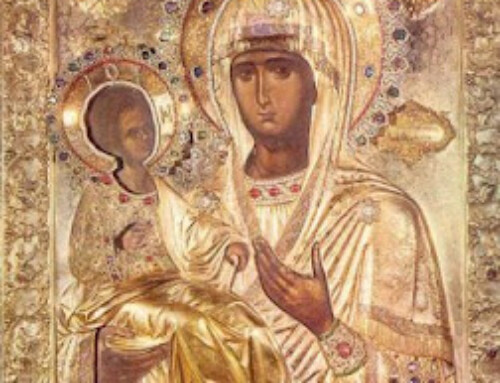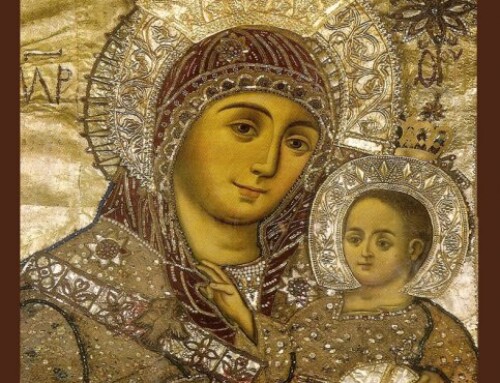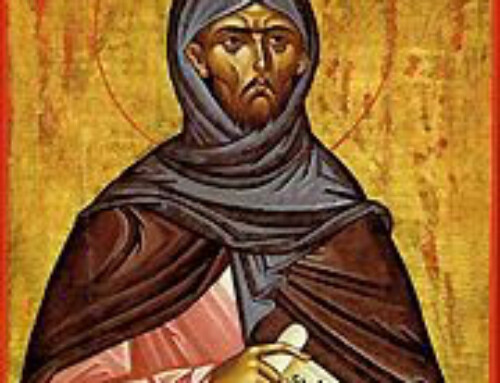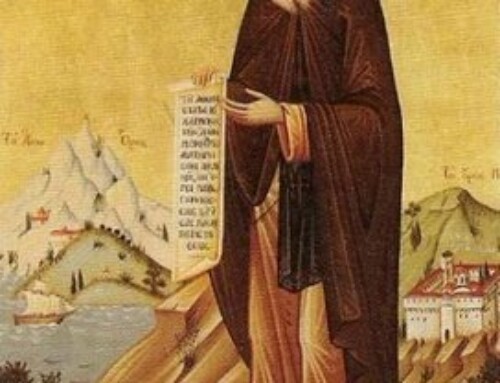Saint Seraphim of Sarov
was born on the 19th of July, 1759. His birthplace was Kursk, Russia, a town famous for its miracle-working icon of the Mother of God. At birth he was named Prokhor, after the disciple of Saint John the Theologian.
While still a small child, Prokhor’s father died and his mother, Agatha, took over the family business, as well as sole responsibility for the upbringing of the children. She was a God-fearing woman with a strong and noble character.
When he was 10 years old, Prokhor fell ill with a life threatening disease. During one sleepless night the Mother of God appeared to him telling him that he would recover. Shortly afterwards, the Kursk icon was being carried in procession through the town and his mother carried him to it. In fulfillment of the prophecy, he was miraculously healed. This was the first, but by no means the last dramatic intervention of his life of the Mother of God. In fact, the Saint’s intense and intimate relationship with Mary was to characterize his entire life.
When he finished schooling Prokhor went into business with his brothers as a merchant-a life which held no attraction for him. From the time of his healing as a small boy of ten, Prokhor’s only real interest in life was the Kingdom of God. His chief occupation, when not busy with his daily duties, was reading the Scriptures and the Fathers. His first real desire was to be a monk and go to Sarov, a famous Russian monastery of his time.
Such a decision was not to be made lightly. Seeking confirmation, Prokhor went on a pilgrimage to Kiev, the cradle of Russian Christianity. He set off with several other young men, and upon arrival at the monastery received confession and communion. Then he visited a staretz (a wise man or elder) from whom he might gain direction. He was greeted with the words, “You will go to Sarov, and your earthly pilgrimage will end there.” Though amazed that the Staretz knew where he was thinking of going, Prokhor was delighted. The Staretz went on to say, “The Holy Spirit will guide you in the life and will make you His dwelling.” Prokhor needed to hear nothing more. Quickly settling his affairs at home, he departed immediately for Sarov.
THE MONASTERY AT SAROV
Prokhor was nineteen years old when he entered the monastery. It was the eve of the Feast of the Entry of the Mother of God into the Temple. He threw himself into the monastic life with great zeal, and soon became popular with the other monks. Often, returning from a hard day’s work, the monks would be tired and too dejected to begin a long vigil of prayer. He would joke with them as they came into the choir, cheering them up so that they would go on. He used to say later when he was a spiritual father to many monastics, “The Lord wants people to be happy with Him; and to say an encouraging word, even if it is in Church, can hardly be a sin.”
He took his monastic vows in 1786, and was given the name Seraphim. A year later he was ordained deacon, and the tremendous intensity of his prayer life was already apparent. One day he was serving in the monastery Church. As the Liturgy progressed the time came for the entrance with the Gospel. In his own words, Saint Seraphim tells the story.
“While I was standing before the Royal Doors, I was suddenly dazzled, as though by a sunbeam and, as I glanced toward that light, I saw our Lord Jesus Christ, in His aspect of Son of Man, appearing in dazzling glory surrounded by the heavenly hosts, the seraphim and cherubim. He was walking through the air, coming from the West Door towards the middle of the Church. He stopped before the sanctuary, raised His arms, and blessed the celebrants and the people. Then, transfigured. He went into His icon by the Royal Door, still surrounded by the angelic escort, which continued to illumine the Church with its shining light. As for me, who am only dust and ashes, I was given the grace of receiving an individual blessing from the Lord so that my heart overflowed with joy.”
Witnesses of this event said that Seraphim’s face became as a flame. He stood transfixed and had to be guided back into the Sanctuary by two deacons so that the Liturgy could continue. He stood where they placed him for over two hours.
INTO THE WILDERNESS
After sixteen years in the monastery, Seraphim desired to carry the intensity of his prayer even further. He went into the forest to be a hermit, leaving the community life of the monastery and building a little hermitage for himself out of wood. Here he sought to characterize the whole of his life by worship. He named certain places around the land he was cultivating after places described in the gospels. This place was the Jordan, that place was Bethany where the Lord would go and eat with Martha and Mary and Lazarus, and this place was Calvary. He used to go around and pray in these places and remember the events in the Lord’s life—this was a physical way to reinforce the fact that he was living purely in the gospels.
As well as prayer, reading the gospel was his favorite occupation. He used to say later on, “I never let a single day go by without this reading, because not only is my soul gladdened by the divine word, but even my body is refreshed by it. It is like talking to the Lord when I call to mind His life and passion. Night and day I ascribe glory to Him, worship Him, and thank Him for His goodness.” Later on Seraphim told his spiritual children: “Read the gospel, read the gospel, read the gospel, live in the gospel.” He used to say that the mind ought to swim in the gospel like a fish swims in the sea.
Once a week he used to go back to the monastery for the Divine Liturgy, and would bring back with him a bag of bread. The rest of his food he grew himself. Sometimes monks would go back with him to the hermitage, and would see him distributing his bread to the wild animals. Here again we can see the fruits of his intense life of prayer. Even the relationship between man and the animal kingdom is restored in those who are truly full of the Holy Spirit. They restore the relationship of Adam with the animals as it was before the fall. This was very apparent in Saint Seraphim: he was once seen feeding a bear with the bread that he had in his satchel.
Despite his seclusion, rumors about him began to spread. There even came to be a report among certain people that he had gold in his hut. When robbers came to his hut with the intention of stealing this gold, he did not resist, although he was strong and happened to be carrying an axe. The two robbers beat him nearly to death. They went into the hut, pulled open the bag that he slept on, and found that it was just full of rocks. Panic stricken, they ran away half-crazed.
Seraphim was left unconscious, but did recover enough to drag him self back to the monastery, where he was taken to the infirmary. He was found to have had a fractured skull as well as other injuries.
Once again the Mother of God appeared to him and healed him, although this incident left him crippled for the rest of his life. When the robbers were later apprehended, Saint Seraphim refused to have them prosecuted. They threw themselves at his feet in complete repentance and contrition.
STARETZ SERAPHIM
Seraphim returned to the forest. He re-doubled his life of prayer, later on admitting in a guarded way that during that time he spent a thousand nights and days kneeling on a stone praying to God. However his time as a hermit was soon to come to an end. In 1810, a new abbot of the monastery became worried about the unusual nature of Seraphim’s life. By that time he wasn’t even going back to the monastery for Holy Communion on Sundays.
The abbot sent a monk with a message that he had to return to the monastery. The first time the monk came, Seraphim didn’t say anything. The second time he simply got up and followed the messenger back to Sarov. Immediately he shut himself in a cell and for five years he stayed there in absolute seclusion. Sometimes he would come out at night to take a walk around the monastery, but to all intents and purposes he lived only in his cell.
In 1815, the greatest fruit of all those years of intense prayer and fasting began to be apparent. For no reason that the outside world could see, directly acting on inspiration from the Lord, he opened his cell door to someone who came and knocked on it.
Seraphim was given an amazing ability to communicate the love and forgiveness and warmth of God to other people. When people came to him the Lord told him what was in their heart and what they needed to hear in order to understand God’s healing and love and mercy. People came to him, and were astonished that he knew things about them which no other human being could normally know. Thousands of people had their relationship with God healed through what he had to say. Many others were healed physically through his prayer.
From this time onward people came to Seraphim for counsel and all-around help. They found in him an “Elder”—one in whom the grace of the Holy Spirit is so powerfully present that God works through him countless miracles of physical and spiritual healing.
This new ministry meant that throngs of people began to come to the monastery every day. This wasn’t easy for the monks. Their normal, peaceful life was being disrupted by the thousands of people crowding in. Seraphim suffered a great deal of opposition from some members of the monastery. He also experienced a tremendous amount of physical sickness and pain. The amazing grace of God which flowed out of this elderly Saint did not come without a price.
Directly in obedience to the Mother of God, Saint Seraphim chose a number of young girls, whom he formed into a monastic community. He trained these girls in the spiritual life in an extremely intense and direct way. This relationship became especially important later on, because the sisters preserved teaching and information about him which otherwise would have been lost.
Saint Seraphim also had a particularly close relationship with two men, Michael Manturov and Nicholas Motovilov. These men, both of whom were married, became his confidants and guardians of the convent after his death. It was to Motovilov that he gave one of his most important messages, a message about the goal of the Christian life.
He died in 1833, kneeling in front of an icon of the Mother of God and reading the gospels—a posture which epitomized his life. Saint Seraphim was revered in life, and in 1903 was canonized on his birthday, the 19th of July. The Russian royal family were present at his canonization along with thousands and thousands of others. There was even a granddaughter of Queen Victoria present, who wrote to her sister in England about the joy and wonder of the event, and the many miracles that took place.
Much more could be said about the life of this fascinating saint. For further reading, I recommend Saint Seraphim of Sarov by Valentine Zander (Saint Vladimir Seminary Press, 1975). This book was the inspiration for much of this article.
It still remains to look at the personality of Saint Seraphim, and the theological wisdom which he imparted to the Church. This, however, will be left for a later time.
Sister Sarah
Parish of Saint John of Kronstadt
Bath, England
“I was suddenly dazzled, as though by a sunbeam, and I saw our Lord Jesus Christ, appearing in dazzling glory surrounded by the heavenly hosts.”





